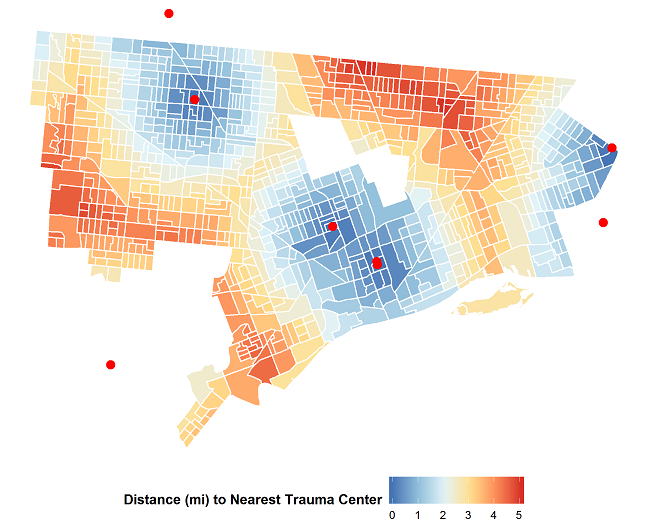
As part of the firearms special issue, author Giovanni Circo has contributed this blog post that articulates with his Original Article: Distance to trauma centres among gunshot wound victims: identifying trauma ‘deserts’ and ‘oases’ in Detroit
Giovanni Circo is an assistant professor in the Henry C Lee College of Criminal Justice at the University of New Haven in West Haven, Connecticut. His research has focused on gun violence and evaluating evidence-based methods to reducing crime in urban areas. He has worked extensively on programs in Detroit, Michigan – most notably the Ceasefire Detroit and Project Green Light Detroit initiatives.
The idea for this study began on a site visit at one of Detroit’s major hospitals and trauma centers. This particular hospital I was visiting treated a large share of gunshot wound victims from much of the Western part of the city. I had previously been reviewing several hundred fatal and non-fatal shooting reports and had noted that this hospital was one of the most common sites for victims. Something that struck me was that gunshot wound victims from all over – some very close, some quite far, were driven to this hospital for treatment. What would happen, I thought, if I was unlucky enough to be a victim in a neighborhood much farther from a hospital with a trauma center? Would an extra 10 minutes be enough to impact my survival? As a criminologist we are trained to think about neighborhoods, and how things like poverty or segregation affect health or crime outcomes. What if the neighborhood you lived in had some impact on whether you were likely to survive a potentially fatal gunshot wound?
My study in Detroit examined neighborhood-level variables predicting the rate at which gunshot wound victims typically survive their injuries. Using data on fatal and non-fatal shooting victimizations over a seven-year period I studied the outcomes of over 9,000 victims. What I was particularly interested in was identifying portions of the city which had above-average rates of gunshot wound fatalities, with the distance to the nearest trauma center as a predictor. To do this I first calculated the distance from each census block group to the nearest trauma center, which gave me a rough estimate of the distance someone in that neighborhood would have to travel to get treatment. Next, using a conditional autoregressive model (essentially, a fancy term for a regression that takes into account the spatial relationship between regions) I generated estimates of survival based on the distance from the block group to the nearest hospital, while controlling for poverty and demographic variables.
What I found surprised me – especially when I mapped the survival estimates across the city of Detroit. Consistent with earlier research in Chicago my model identified that block groups father from trauma centers had elevated rates of gunshot wound fatalities compared to other parts of the city. What surprised me was when I looked at clusters of neighborhoods I found evidence of trauma “oases” – that is, areas immediately around trauma centers with lower rates of gunshot wound fatalities. On average about 21% of gunshot wound victims die of their injuries in Detroit. Among those living in these “oases” the rate was about 17% – a nearly 3 percentage point difference. While this might not sound significant on paper, in a city with over 1,000 gunshot wound victimizations each year, this number equals lives saved.
My study is just one of several which have begun to look at this important issue. We often forget that criminal victimization can be thought of not only as a legal issue, but also a public health issue. The burden that gunshot wound injuries and deaths place on communities is immense. Improving access to trauma care is likely one piece of the puzzle to addressing the tens of thousands of gunshot injuries each year in the United States. One thing we will have to consider in future research is the importance of neighborhoods and features that affect the health of well-being of its community members.